
NEW Basic Mechanics course
Ler maisEngenharia mecânica é a aplicação de física aos elementos que nos rodeiam para melhorar os dispositivos mecânicos existentes ou criar novos dispositivos. Uma vez que se baseia em princípios físicos, a sua origem remonta à origem desses princípios e o seu desenvolvimento está estreitamente ligado aos avanços em mecânica. No entanto, não foi até à invenção do motor vapor que se tornou um dos pilares do desenvolvimento da indústria.
Ver maisA Revolução Industrial do século XVII teve lugar como resultado da criação deste dispositivo. A partir desse momento, com as contribuições de cientistas e engenheiros tão importantes como Watt, Stephenson, Tesla ou Rankine, iniciou-se uma renovação sem precedentes tanto do conceito como do desenvolvimento de novas máquinas.
O conceito de indústria, como era conhecido até esse momento, mudou com o desenvolvimento dessas máquinas. Produção de massa foi implementada, máquina desenhos foram melhorados e, consequentemente, a gama de processos de produção foi aumentada, resultando numa variedade impensável de novos produtos adaptados às necessidades da sociedade.
Na engenharia mecânica, vale a pena mencionar os seguintes campos de estudo e aplicação:
No presente, qualquer indústria, desde alimentos até aeroespacial, debe estar ao mais alto nível de tecnologia inovação. Portanto, pesquisa e desenvolvimento de novos dispositivos é particularmente importante ter sempre o mais recente tecnologia e estar ao nível exigido pela indústria 4.0.
Ver produtos